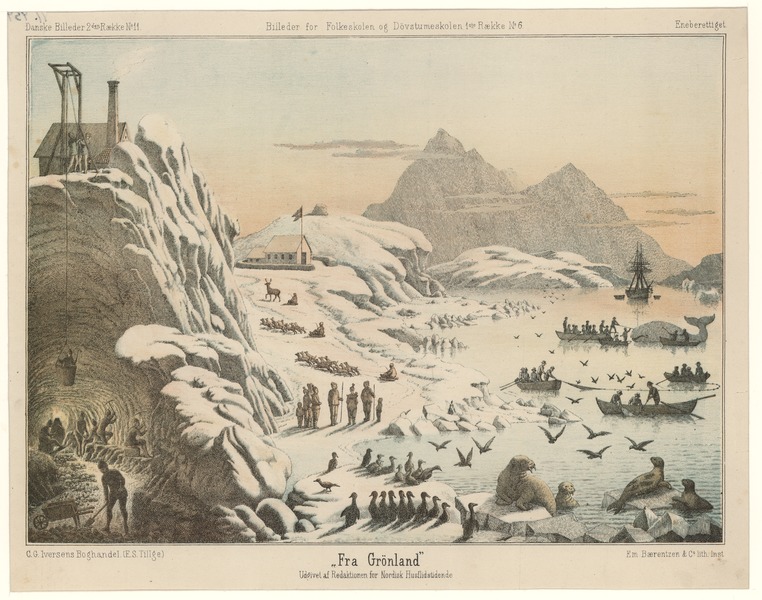President Donald Trump’s announcement that he was looking into buying Greenland, an autonomous territory of Denmark, was treated with derision by Danish politicians, Twitter users around the world (the idea was announced on the president’s Twitter account), and by television comedians.
It turns out that the United States has tried to buy Greenland twice before. The U.S. State Department asked about a possible sale in 1867, and President Harry Truman made an offer after World War II. From a historical perspective Trump’s impulse to expand American territory seems entirely consistent with the American story.
By the time historian Frederick Jackson Turner published his seminal essay entitled The Significance of the Frontier in American History in 1893, the American frontier had ceased to exist.
That hasn’t stopped subsequent American leaders from seeking out new frontiers to provide the American people with the resources and dynamism their quickly advancing industrial state required. It is probably no coincidence then that five years after Turner published his world-shaking thesis, America acquired its first colonies as a result of the Spanish-American War (Puerto Rico, the Philippines and Guam, in case you’ve forgotten). Hawaii was also annexed the same year. Later, the U.S. Virgin Islands were purchased from Denmark in 1917.
While America added some Pacific Islands to its possessions in the wake of World War II, the frontier in America in the 20th century became more abstract. There were now frontiers in science, frontiers in medicine, frontiers in agriculture, and frontiers in technology. Today, businesses imagine “strategic frontiers.” Now, artificial intelligence is considered “the next frontier.”
There was, of course, the brief flirtation with space as a new frontier. But that turned out to be more science fiction than fact. Only in the television series Star Trek did humans actually settle on other planets across the galaxy. In fact, one of the subsequent Star Trek films was subtitled “The Final Frontier.”
America’s love affair with the frontier stems in part from its desire to live beyond politics. Out on the frontier in the 19th century, a settler could find cheap land and favorable farming conditions. Settlers could be far from the influence of Eastern bankers and Washington politicians, in fact, from all Eastern institutions including established churches that might try to dictate their lives. The light hand of territorial administration was far more satisfactory.
What Americans thinking along these lines failed to grasp was the role of those bankers and politicians in providing the conditions suitable for settlement by Europeans and Africans brought over as slaves. Those conditions included forts that challenged Native American tribes and protected settlers. They also included administration of land sales in fresh territories. And they included the vast lands and subsidies offered to railroads which linked frontier areas to the East, an East that proved a ready market for the produce of the frontier areas. And it turns out that Eastern bankers provided much of the finance necessary to make all of this happen.
The idea of the lonely, isolated and wholly autonomous frontiersman was an illusion from the start. What lay behind the hunger for the frontier was a hunger for resources for the factories and mills supplying a growing population, growing both in number and in wealth. The boundless appetite of capitalist society seems only to be satisfied temporarily before it moves on.
When mineral resources were drawn down over time in the United States, U.S. miners looked to Africa, Central and South America and Asia for new untapped lands. And, since so much of modern industrial society depends on finite, nonrenewable minerals and energy resources, exhaustion of resources in one place necessitates a move to another.
Which brings us back to Greenland. It turns out that Greenland is believed to have vast mineral riches including oil. What is making these resources more inviting is the rapid melting of the Greenland icecap which covers those riches under an average thickness of ice 1.2 miles deep. It is, of course, an irony that the oil which Trump would like the United States to extract from Greenland’s soil and waters is responsible in large part for the warming that is melting the icecap.
The most immediate prize, however, is rare earth minerals needed to manufacture the high-tech gadgets that now run our world. With Chinese supply dominating that market, it is easy to see why Trump might want the United States to gain control of such minerals itself.
The fact that humans are looking for those minerals on an island covered 80 percent by a thick sheet of ice is an indication that much of the good ores have been mined elsewhere. The maw of industrial society, however, never thinks about long-term consequences or trends, only about where it will get its next meal of mineral and other resources. The logic of that appetite is as relentless as it is perilous.
It seems unlikely that Greenland will sell itself to the United States. There really is no necessity for that if the goal is only to get the mineral resources out. The people of Greenland can arrange for that themselves.
It’s not really the resources of Greenland then that are fueling the interest in buying Greenland and adding it to the United States. It is the lure of the idea of the frontier, a vast open wilderness waiting to be tamed by good, hearty, independent folk seeking to forge a new and autonomous existence for themselves. That fantasy remains a powerful one among Americans and it suggests that the idea of purchasing Greenland will likely resurface as an expression of the desire for an existence not weighed down by the ties of established communities and heavy-handed government administration and therefore a respite from the contentious politics of our day.
Image: “From Greenland” (1871). Lithograph of animals, landscape and human activities of Greenland. Norsk Husflid Tidende (Nordic Housecrafts Journal, Denmark) via Wikimedia Commons. https://commons.wikimedia.org/wiki/File:Fra_Gr%C3%B8nland(11454).tif






